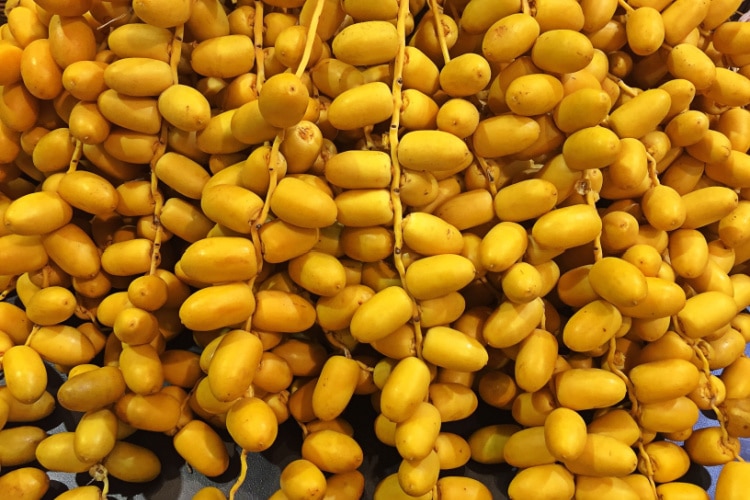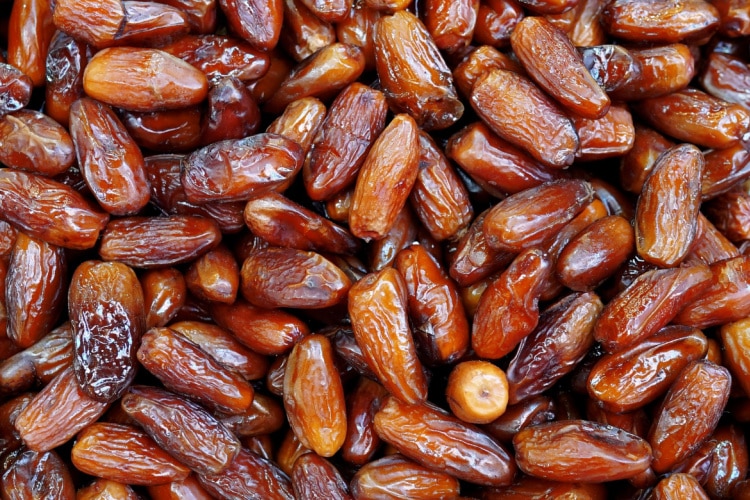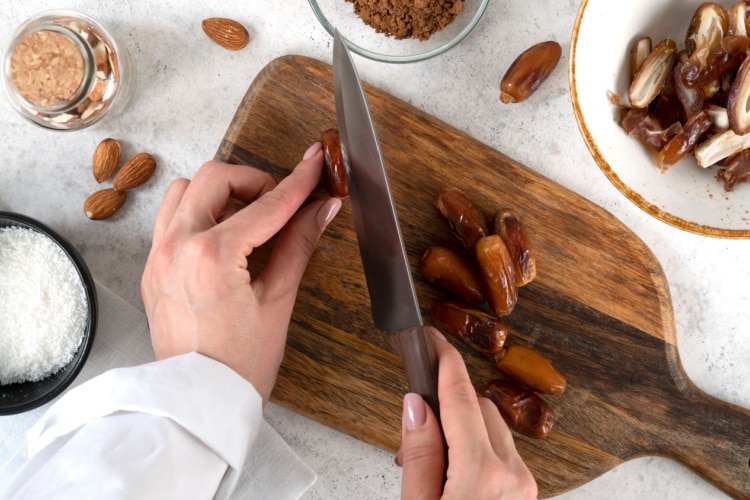Dates are tiny fruits that are naturally sweet – they are considered to be one of the sweetest fruits in the world! Their name, a Greek word for “fingers,” alludes to their shape.
They’re one of the rare fruits that are part of almost every culture’s cuisine.
Regardless of whether you love your dates dried or fresh, we will look at both in this guide.
We’ll look at their differences – one of the main ones being their moisture content.

Let’s dig in!
Dried Dates V.s Fresh Dates: What’s The Difference?
Let’s dive straight into the differences between dried dates and fresh dates.
Their moisture content is the primary distinction between fresh and dried dates.
There are two types of fresh dates: unripe, also known as Khalal, with 80% moisture content, and ripe, also known as Rutab, with a moisture level of 50% to 70%.
Fresh Dates
As they are dried under direct sunshine, dried dates, also known as Tamr, have the lowest moisture content with just 10%.
For this reason, they are sometimes referred to as sun-dried dates.
Dried Dates
These dates differ in more ways than their moisture content.
They are also distinguishable from fresh dates by their harvesting period, size, color, flavor, texture, and shelf life.
We’ll look at this more below.

Dried Dates vs. Fresh Dates: Harvesting Period
Dried versus fresh dates are not different types; rather, they are simply harvested at different maturity levels.
Fresh Khalal dates are harvested while they are still immature.
They are the rarest dates available, but they are also the freshest.
Nevertheless, you won’t be able to enjoy their freshness unless you live where dates are grown during the period in which they are harvested, which is in August.
Fresh dates achieve their peak maturity during the Rutab stage, at which point their texture, flavor, and appearance are very different from Khalal dates.
Rutab dates are left on the trees to mature for a little longer and are harvested in September and October.
Both of these fruits will eventually become dried dates, which are considered to be their “final” form.
Dates are at their driest during this period because they’re left to dry in the Sun until December, also known as the Tamr stage.
Tamr or dried dates are the most widely distributed kind worldwide.
Dried Dates vs. Fresh Dates: Size
Dates start to dry up and shrivel as they mature. Hence, dates are their largest size at the unripe stage of harvesting.
Fresh ripe dates are slightly smaller than fresh unripe dates, whereas dried dates are the smallest.
Dried Dates vs. Fresh Dates: Color
As dates get older, they darken.
Fresh, unripe dates are pale yellow, whereas fresh, ripe dates are light brown in color.
Dried dates tend to be dark brown.
Dried Dates vs. Fresh Dates: Flavor
The flavor of fresh, unripe dates is moderately sweet and reminiscent of apples and coconuts.
Fresh, ripe dates are substantially sweeter. At this point, the date starts to taste like caramel.
The sweetest dates are dried ones. They have a more pronounced chocolate taste reminiscent of toffee and butterscotch.
Dried Dates vs. Fresh Dates: Texture
Fresh, unripe dates have a crisp, firm flesh resembling a pear’s feel.
They become soft and very juicy as they mature, to the point of nearly melting on your tongue.
Dried dates aren’t as juicy, but they are nevertheless tender.
Dried Dates vs. Fresh Dates: Storage & Shelf life
Both fresh and dried dates must be stored in an airtight container to maintain quality.
Fresh dates obviously lose their freshness faster than dried dates.
Fresh dates may be refrigerated for up to 8 months and frozen for one year.
Dried dates may be refrigerated for up to one year and frozen for up to five years.
Dried Dates vs Fresh Dates Comparison Table
| Category | Dried Dates (Khalal & Rutab) | Fresh Dates (Tamr) |
| Harvesting period | Khalal dates: when unripe Rutab dates: when fully ripe | When fully dried under direct sunlight |
| Harvesting months: | Khalal dates: August Rutab dates: September: October | December |
| Moisture content | Khalal dates: 80% moisture Rutab dates: 50-70% moisture | 10% moisture |
| Size | Khalal dates: the biggest Rutab dates: smaller | The smallest |
| Color | Khalal dates: pale yellow Rutab dates: light brown | Dark brown |
| Flavor | Khalal dates: mildly sweet (similar to apples and coconuts) Rutab dates: much sweeter (similar to caramel) | The sweetest (similar to toffee and butterscotch) |
| Texture | Khalal dates: hard and crunchy, similar to pears Rutab dates: juicy and soft, almost melts in the mouth | Meaty mouthfeel, soft, but not as juicy |
| Storage | Sealed in an airtight container | Sealed in an airtight container |
| Shelf life | Refrigerated: up to 8 months Frozen: up to 1 year | Refrigerated: up to 1 year Frozen: up to 5 years |
Which Is Better, Dried Dates Or Fresh Dates?
We’ve included a nutritional table below to assess whether dried or fresh dates are better for you.
We can see that dried dates have more calories than fresh dates. The reason why fresh dates are less calorific is due to their higher moisture content.
As a date’s moisture content falls, its natural sugar content rises, increasing its caloric content and sweetness.
In terms of macronutrients and micronutrients, dates — both fresh and dried — are packed with them! Dried and fresh dates have zero fat and are marginally different in protein.
However, dried dates have higher carbohydrate and fiber content than fresh dates.
Iron, magnesium, and vitamin A are among the nutrients they have equal amounts. Dried dates are also superior sources of calcium and potassium.
| Category (1 date) | Dried Dates | Fresh Dates |
| Calories | 66.5 | 55 |
| Carbs | 18g | 15g |
| Fat | 0g | 0g |
| Sodium | 0.2mg | 0mg |
| Potassium | 167mg | 131mg |
| Protein | 0.4g | 0.5g |
| Fiber | 1.6g | 1.5g |
| Sugar | 16g | 12.5g |
| Vitamins & Minerals | ||
| Calcium | 15.4mg | 9.5mg |
| Iron | 0.2mg | 0.2mg |
| Magnesium | 13mg | 13mg |
| Vitamin A | 1.7μg | 1.7μg |
Can I Substitute Dried Dates for Fresh Dates and Vice Versa?
Unripe Khalal dates cannot be substituted for any other types of dates or even other fruits, to be honest.
However, you can substitute dried dates for fresh, ripe dates without modifying the recipe – this is something I’ve done plenty of times.

Dried and fresh dates can easily substitute one another in the following:
- Date energy balls made with lemon zest, nuts, honey, cranberries, coconut oil, and squeezed lemon juice
- Persian fruit salad with dates, coconut, apricots, bananas, apples, almonds, oranges, and orange juice
- Moroccan date stew with lamb or beef
- Stuffed dates
- Date smoothies with coconut milk, banana, and vanilla.
Conclusion
Dates are harvested in three stages: fresh unripe, fresh ripe, and fully dried.
Khalal dates are fresh, unripe dates with crunchy flesh and a pale yellow appearance. They are very juicy, have a low sweetness, and contain a lot of moisture.
The fresh, ripe dates, Rutab, are light brown, super juicy, and sweet. In this stage, they have a chewy texture and a taste reminiscent of caramel.
Dried dates, or Tamr dates, are very distinct from fresh ones. They have the lowest moisture content and are not at all juicy. They are, however, the sweetest and tastiest of all!
FAQs
You can use dried dates in place of fresh ones by soaking them in warm water to soften them, making them suitable for smoothies, baking, and cooking.
Yes, eating dried dates is beneficial as they are rich in nutrients, fiber, and antioxidants, offering various health benefits.







